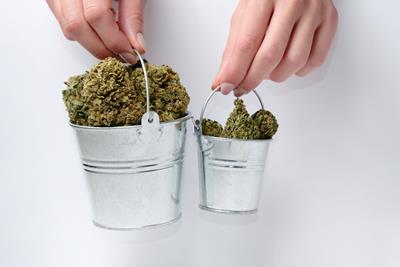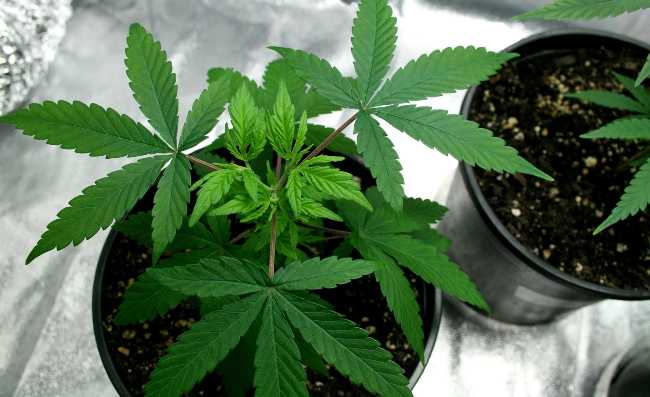
Tuesday February 8, 2022
By Trevor Ross
 Growing
Growing
Space Buckets are a result of the microgrowing trend that values minimalism and accessibility. That is: how can as many people as possible grow as simply as possible? Microgrowing has given us inventions like solo cup growing, and the cannabis bonsai, and now it has brought us the Space Bucket.
In this article, we review what a space bucket is, how to build a space bucket, and what exactly space buckets do.
What is a Space Bucket?
There’s nothing extraterrestrial about space buckets, the name is simply a reference to their small footprint. Space buckets are the latest effort to condense a whole growing operation into a small and subtle self-contained environment. Conventionally, this can be achieved at home using a grow tent, but even modest tents are cumbersome, and ideally require external ventilation hardware that takes up more room, or dictates the location of the tent. Instead, space buckets include lights and fans inside, or just outside the shell of, the humble 5-gallon bucket.
A proper space bucket is also economical. Most designs can be achieved for $100 or less with parts found in common hardware stores. SpaceBuckets.com even has a tool to help users design their bucket while displaying a bottom-line cost with links to the appropriate hardware.
Space buckets will not produce large yields, or anything comparable to a proper grow tent. A full-sized plant in a tent will yield about 16 oz, or one pound. Conversely, a space bucket will probably yield an ounce, improving with experience.
How to Build a Space Bucket
What does it take to build one of these miniature cultivation stations?
Grow Space
Begin with three (3) black 5-gallon buckets with lids (or at least one lid). Black won’t be the cheapest option, but lighter buckets will require black tape to be wrapped around them anyway, which is another cost. However you choose, the goal is the same: no light leaking in or through. Remove any handles.
Select your bottom bucket and drill holes in the bottom for water drainage. Set aside the top bucket, and the third bucket will be cut apart.

Using a sawzall or hacksaw, cut the top ring from this bucket to use as a spacer between the top and bottom buckets, giving your plants a few extra inches to grow (additional buckets may be sacrificed for additional spacing rings). Seal it together with duct tape. Then cut off the bottom of the bucket to place beneath your bucket with drain holes. This bottom layer will catch water leaching through the soil.
Ventilation
Next, the bucket will need air intake and exhaust from two fans. 4-inch muffin fans can be found for about $20, or 80mm computer fans work, but will require their own 12v power supply, and still don’t move as much air. Cut a hole for the intake at the bottom of the bucket, and another for exhaust at the top, and seal the fans in with tape. Carbon filters may be required over those if you want to completely conceal the smell.
Lighting
Lighting may be tricky because you need a light that fits inside the lid, so check dimensions carefully before purchasing. LED lights are compact, powerful, and frankly easier than options like HID bulbs. Circular UFO lights are expensive, but work perfectly. Or you could mimic a UFO light with an LED strip run inside the bucket.
Additional Materials
The inside of the bucket can be made reflective with a roll of Mylar or the roll of foil in your kitchen. Use glue or double-sided tape to stick it to the inside of the bucket.
A thermometer can be dropped in anyplace, and many now send data to the user’s phone. Watering may be automated with electronic water pumps, or simply a watering bulb stuck in the soil. Either of these will relieve you of having to open the bucket so often.

Of course you will also need the soil of your choosing. Fill the bottom bucket with 8-10 inches of soil, or place a smaller 3- or 4- gallon pot inside.
By now there are probably several wires hanging from your buckets. Many growers secure these to the bucket itself, along with a power strip attached to the side. Of course, the wires can run across your floor if no one cares, but condensing the whole setup into one bundle is part of the fun.
Conclusion
If all of the above sounds like too much work, space bucket grow kits can be purchased online, as well as pre-built buckets from sites like Etsy.
There is no strain that does better or worse in a space bucket, but consider using autoflowering seeds. Photoperiod plants can still grow in these settings, but they will require more ruthless attention to lighting cycles, or at least a timer switch, which adds to the final cost. Autoflowering plants are sometimes criticized for offering smaller yields, but in microgrow settings, a photoperiod plant would be pruned half to death anyway.
The original space buckets were designed for subversion in closets and other small living spaces, but the principles can scale up using larger buckets, totes, or even a trash can, and blend in just as well in attics, basements, and garages. Check out the space bucket subreddit for some fun designs.
What’s your latest space bucket setup look like? Tell us in the comments below!
Photo Credit: Shutterstock







